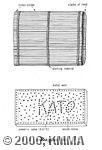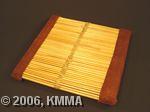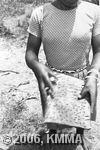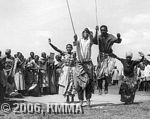





Other names: akayenkye, orunyegye, akahuubaano, akayamba, orukyenkye, sungura
The rugaaniire is a box-shaped rattle made from the stems of the reed plant; it measures on average 25 to 30 cm in length, 10 to 23 cm in width and 2 to 3 cm in height. The walls of the rugaaniire are made of dried reeds bound tightly together with raffia or papyrus around three parallel wooden pegs, two at the ends and one in the middle. This creates two separate compartments which are filled with canna seeds or dried beans. Sometimes a few crown caps, coins or other small metal objects are added to the seeds to produce a richer sound. The sides are filled in with a piece of banana leaf or a wad of cotton to prevent the seeds from falling out.
Nowadays box-shaped rattles are also made from metal. Two metal plates are hammered onto a wooden frame and Tthe metal plates are pierced many times with a nail or other sharp object. The owner sometimes writes his name in the instrument using the same method. Like the reed rugaaniire, the metal rugaaniire has two compartments that are filled with seeds.
The rugaaniire is made by women and young girls. One instrument can be made in a day and it is cheap to make.
The player holds the rugaaniire along the sides with both hands. There are two playing methods, which are always combined: shaking the instrument up and down and striking the top of it with the thumbs, which increases the rhythmic effect.
The rugaaniire is usually played by women, but sometimes men play it too. The instrument is not played solo but is always combined with percussion, rattles and clapping. All population groups in Ankole use the rugaaniire except for the Hima.
for more information see also: VAN THIEL, Paul, "Multi-Tribal Music of Ankole. An ethnomusicological study including a glossary of musical terms." Edited by the Royal Museum for Central Africa, Annales, Sciences Humaines, nr 91, 1977, 234 pp.
© KMMA/Paul VAN THIEL